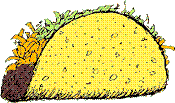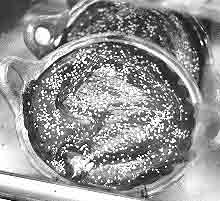 The main
pleasure that mercado food gives, naturally, is in the eating. Nonetheless, Mexican
gastronomy has another angle that is almost as much fun: That of knowing its historical
roots.
The main
pleasure that mercado food gives, naturally, is in the eating. Nonetheless, Mexican
gastronomy has another angle that is almost as much fun: That of knowing its historical
roots.
First of all, let's properly establish the fact that the whole panoply of Mexican cuisine is astonishingly varied and rich. This must be emphasized because Northerners often write off Mexican food as inevitably and monotonously too spicy and too greasy. That's a shame, because many who study the matter insist that Mexican food, when viewed as a whole in terms of diversity of appealing tastes and textures, imagination used in combining ingredients, and being appetizingly presented, compares favorably with any cuisine in the world, including that of the French.
In 1519, when the first Spanish conquistadors entered the Aztec capital Tenochtitlan, where today Mexico City stands, they found the Aztec emperor Montezuma excessively fond of a drink concocted from vanilla and chocolate, and sweetened with honey. This was a native Mexican-Indian dish -- probably invented by the Maya -- later to find worldwide acceptance. Vanilla is a substance derived from the fruit-pod of a certain species of Mexican orchid, and chocolate comes from the fruit of the Mexican cacao tree. The conquistadors were further impressed by the variety of foods enriching Aztec diets.
You could say that corn and beans are the two main foods of indiginous Mexicans, and much of Mexican cuisine is based on these two ingredients. There's something interestings to think about here. That is, corn and beans have "complimentary amino acids."
Amino acids are the building blocks of protein, which the body absolutely needs. If any one of several amino-acids is missing from a person's diet, then the production of protein is restricted; the body ceases functioning, or performs at a diminished level. It happens that neither corn nor beans supply the full complement of amino acids needed for protein synthesis. However, put the two together like parts of a puzzle, and you magically gain the full complement of amino acids needed. Put rice and corn together, or wheat and rice, or corn and potatoes, or potatoes and beans, and you don't. Put corn with beans, and you do.
One wonders to what extent the ancient Aztec and Maya cultures owed their glory to the homey little fact that somewhere along the line they began eating corn tortillas smeared with bean paste...
During the 1520's, the Spaniards imported into Mexico plants and animals that no Mexican had ever seen. These included horses, cattle, pigs, sheep, goats, and chickens. Among the condiments that also were introduced were olive oil, cinnamon, parsley, coriander, oregano, and black pepper. The Spaniards likewise introduced nuts and grains such as almonds, rice, wheat, and barley; and fruit and vegetables such as apples, oranges, grapes, lettuce, carrots, cauliflowers, potatoes (these brought from Peru), and sugarcane (whence comes sugar).
Quesadillas are one of the mainstays of Mexico's street-side stands, and are considered quintessential Mexican. It turns out that they, like Mexicans themselves, are hybrid creations, half indigenous and half Spanish. The corn tortilla on which quesadillas are based is native American; the cheese, as well as the pork, and/or beef that may accompany the cheese, is Spanish; of the garnish, the hot-sauce made with chili pepper is indigenous, but the shredded lettuce is Spanish.
During colonial times, experiment-minded Spanish women and members of Spanish religious orders invented much of today's more sophisticated Mexican gastronomy. Nuns pioneered such now-traditional Mexican fare as the candy called cajeta, fritterlike buñuelos, and the egg-based liqueur called rompope. Also from the colonial period comes such fare as Lomo en adobo (pork loin in a spicy sauce), chiles rellenos (chilies stuffed with cheese, beef or pork), guacamole (avocado, tomato, onion, chili and coriander), and escabeche (marinades).
 To get an idea of what a fancy Mexican dish
is like, let's consider Mexico's most fervently honored dish, mole poblano, of
which two sesame-seed-sprinkled dishes are shown at the right, as photographed
through a store window in Puebla. Each dish is about a foot across. Mole
(pronounced MOHL-leh) is a very rich, thick sauce made from several kinds of pepper and a
remarkable number of seasonings, which vary from recipe to recipe, and which can number
over a hundred different items. Among the prime ingredients of one recipe are ground
peanuts, sesame and anise seed, cinnamon, salt, black pepper, sugar, garlic, onion, clove,
coriander, tortilla, wheat bread, tomato, raisins, lard, pieces of pork, and... chocolate.
Don't forget that chocolate is a native Mexican invention, so it has every right to be
here.
To get an idea of what a fancy Mexican dish
is like, let's consider Mexico's most fervently honored dish, mole poblano, of
which two sesame-seed-sprinkled dishes are shown at the right, as photographed
through a store window in Puebla. Each dish is about a foot across. Mole
(pronounced MOHL-leh) is a very rich, thick sauce made from several kinds of pepper and a
remarkable number of seasonings, which vary from recipe to recipe, and which can number
over a hundred different items. Among the prime ingredients of one recipe are ground
peanuts, sesame and anise seed, cinnamon, salt, black pepper, sugar, garlic, onion, clove,
coriander, tortilla, wheat bread, tomato, raisins, lard, pieces of pork, and... chocolate.
Don't forget that chocolate is a native Mexican invention, so it has every right to be
here.
Between 1864 and 1867, Mexico was ruled by the former Austrian archduke Ferdinand Maximilian, who was kept in power by French troops. Though Maximilian's reign was brief and tragic, French cooking left its mark on many Mexican-restaurant dishes. French-inspired Mexican dishes include chiles en nogado (stuffed chilies in a walnut sauce), and conejo en mostaza (rabbit in mustard sauce).
REFERENCES
Benitez, Ana de. 1976. Prehispanic cooking, cocina prehispanica. Mexico City: Ediciones Euroamerica Klaus Thiele.
Chapa, Marta. 1983. La comida mexicana y su arte. Mexico City: Editorial Everesto Mexicana, S.A.
Ávila Hernández, Dolores et al. 1988. Gastronomia: Atlas cultural de Mexico. Mexico City: Secretaria del Educacion Publica, Instituto Nacional de Antropologia e Historia.
Novo, Salvador. 1979. Cocina mexicana e historia gastronomica de la Ciudad de Mexico. Mexico City: Editorial Porrua, S.A.
Rivera, Virginia Rodriguez. 1965. La comida en el Mexico antiguo y modemo. Mexico City: Editorial Pormaca, S.A.
During much of its recent history Mexican society has been divided into fairly distinct upper and lower strata, and these two strata eat different foods. Rich folks have benefited from the wonderous mixings mentioned above. Poor folks, particularly the Indians, have eaten a great deal of beans and corn tortillas, and a few other things acquired locally. More than one person has told me that the reason most Mexicans eat chili pepper is to counter their very bland daily diet of beans and tortillas.
Nowadays a Mexican middle class is developing and this class appears to be driving Mexican cuisine into yet a new direction -- a generally northern one. Former tortilla eaters are becoming patrons of white bread. Licuados of papaya or orange are losing ground to Cokes and Pepsis. Many of this new kind of Mexican can't stand hot sauce any better than a gringo. Hamburgers and Kentucky Fried Chicken are all the rage.
Yet, there is still a rainbow of traditional Mexican cuisine out there if you look for it. And there's no better place to find it than in and around traditional mercados.
Enjoy it while you can...